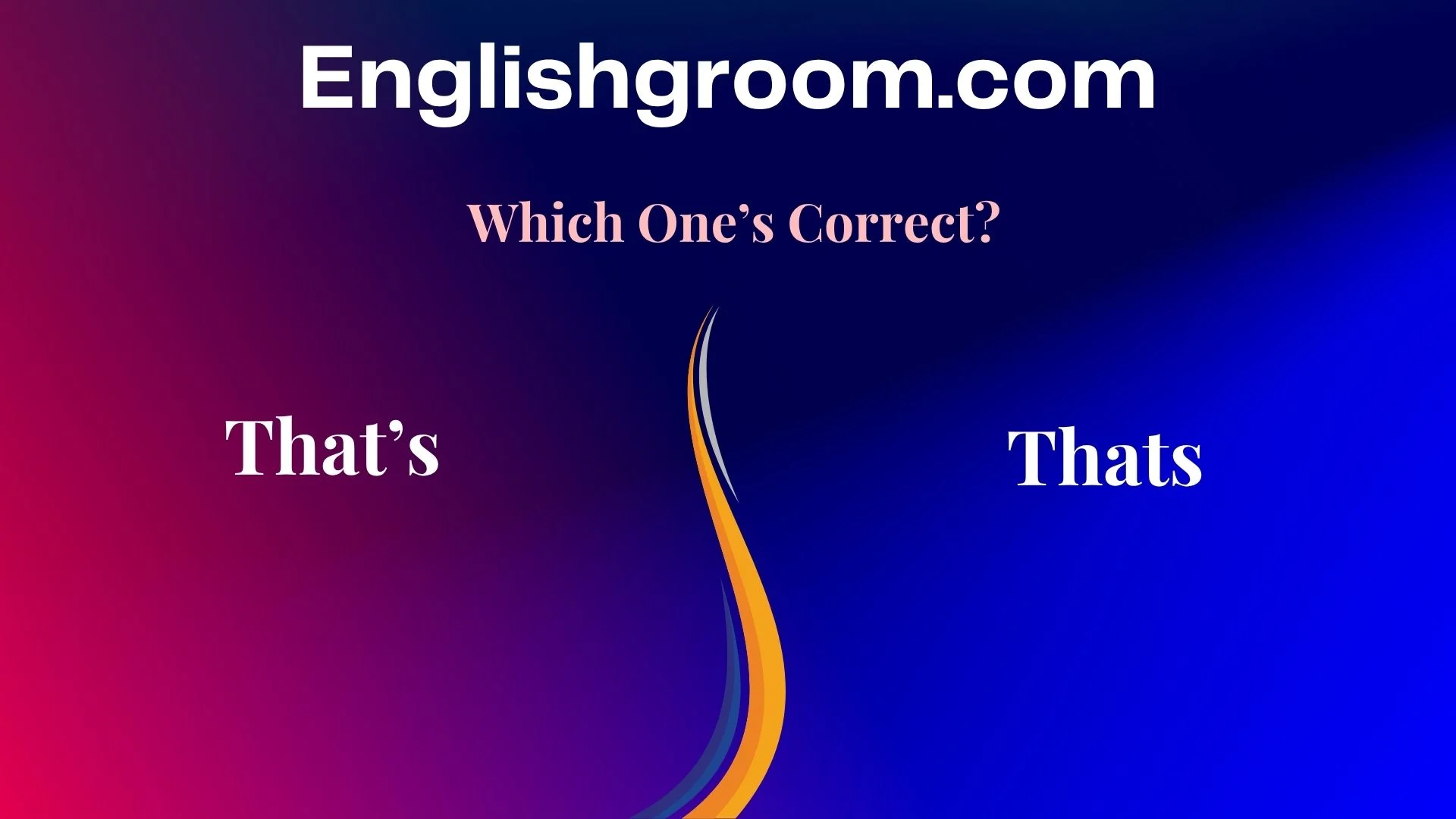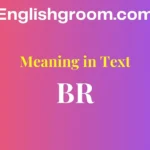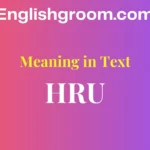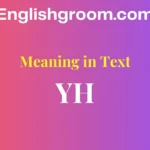Have you ever typed “thats” and paused, wondering if you forgot something? You’re not alone.
The confusion between “that’s” and “thats” is one of the most common grammar mistakes in English.
This tiny apostrophe packs a powerful punch, and once you understand how it works, you’ll never mess it up again.
In this guide, you’ll learn everything about “that’s” vs. “thats” — how they differ, when to use each (and when you shouldn’t), and why a single apostrophe can change the meaning of your entire sentence.
Let’s dive in.
Why This Tiny Apostrophe Trips Everyone Up
English grammar can be tricky. Add texting habits, autocorrect, and quick typing, and you get confusion like this:
“Thats awesome!” ❌
“That’s awesome!” ✅
Both sound the same when spoken. But only one is correct in writing. The reason? Apostrophes show missing letters — and that’s what makes “that’s” different.
This confusion isn’t just among students. You’ll spot it in tweets, emails, ads, and even company slogans. Why? Because our brains process sound faster than spelling.
Here’s the deal: you don’t need to memorize rules like an English professor. You just need to understand what “that’s” actually means — and why “thats” doesn’t exist in most cases.
The Root of the Mix-Up
Why does this simple word cause so much chaos?
- They sound identical – “that’s” and “thats” are pronounced the same.
- Autocorrect doesn’t always help – especially in informal writing or chat apps.
- People type fast – and skip punctuation when it feels unnecessary.
To fix the confusion, let’s quickly refresh two simple grammar concepts:
| Concept | Meaning | Example |
|---|---|---|
| Contraction | A word formed by joining two words and omitting letters. | “That’s” = “that is” or “that has” |
| Possessive | Showing ownership (usually with ’s). | “The dog’s bone” |
The trick? “That’s” is always a contraction, never possessive.
What “That’s” Really Means
The word “that’s” is a contraction, combining “that is” or “that has.”
It’s short, clear, and natural in everyday speech.
Examples:
| “That’s” As “That Is” | “That’s” As “That Has” |
|---|---|
| That’s my car. → That is my car. | That’s gone too far. → That has gone too far. |
| That’s true. → That is true. | That’s been amazing. → That has been amazing. |
Notice something?
Both meanings are perfectly valid — but you can tell which one fits by context.
“That’s amazing” = That is amazing.
“That’s been a challenge” = That has been a challenge.
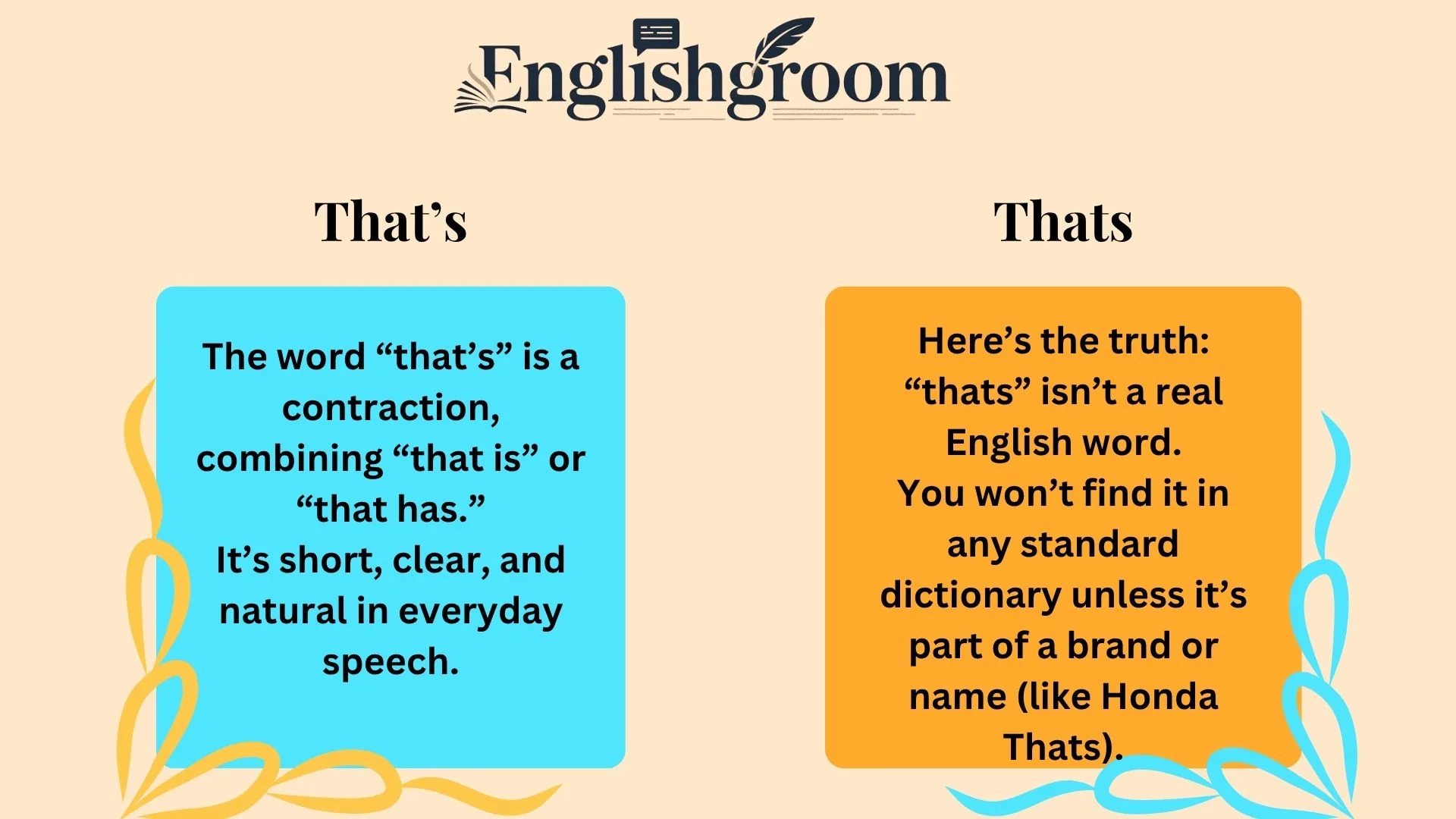
Why “Thats” (Without an Apostrophe) Is Almost Always Wrong
Here’s the truth: “thats” isn’t a real English word.
You won’t find it in any standard dictionary unless it’s part of a brand or name (like Honda Thats).
Let’s see why:
- “That’s” is a contraction → correct.
- “Thats” skips the apostrophe → not a word.
Examples:
- ❌ Thats my bag.
- ✅ That’s my bag. (That is my bag.)
When you leave out the apostrophe, you’re dropping part of the word and changing its meaning. It’s like saying “dont” instead of “don’t.”
Missing an apostrophe might look minor, but it can make writing look careless — especially in emails, resumes, and posts.
When “That’s” Means “That Has”
This is where many people trip up.
“That’s” can mean “that is” or “that has.”
To test which one fits, use this trick:
👉 Replace “that’s” with “that has.” If the sentence still makes sense, you’re using it right.
| Sentence | Expanded | Correct? |
|---|---|---|
| That’s been fun. | That has been fun. | ✅ |
| That’s gone missing. | That has gone missing. | ✅ |
| That’s true. | That has true. | ❌ |
If it doesn’t make sense with “has,” it probably means “is.”
Shortcut Rule: Contractions Are Your Clue
If there’s one golden rule, it’s this:
If letters are missing, the apostrophe must be there.
The apostrophe in “that’s” replaces the missing i in is or the ha in has.
Quick Grammar Hack 💡
- “That’s” = “That is” → missing i
- “That’s” = “That has” → missing ha
Think of the apostrophe as a placeholder for missing letters.
No apostrophe = something’s missing (and the word becomes incorrect).
Mnemonic: If it’s missing letters, it’s missing an apostrophe.
Everyday Examples to Lock It In
Let’s look at real-world examples where people often confuse “that’s” and “thats.”
| Incorrect | Correct | Explanation |
|---|---|---|
| Thats crazy! | That’s crazy! | Missing the apostrophe from “that is.” |
| I think thats yours. | I think that’s yours. | “That’s” = “that is.” |
| Thats been hard. | That’s been hard. | “That’s” = “that has.” |
| Thats the best idea. | That’s the best idea. | Contraction of “that is.” |
Try This Mini Quiz:
- ___ the reason I’m late.
- ___ been a long day.
- I know ___ not easy.
- ___ exactly what I meant.
Answers:
- That’s (that is)
- That’s (that has)
- That’s (that is)
- That’s (that is)
Common Mistakes and How to Avoid Them
Even experienced writers slip up. Here’s why:
1. Confusing “that’s” with “its” or “it’s”
Both follow the same contraction rule, but “its” shows possession.
- “That’s cold” = that is cold.
- “It’s cold” = it is cold.
- “Its color is bright” = ownership, not a contraction.
2. Skipping apostrophes in informal writing
When texting or writing quickly, people drop punctuation. That’s fine in casual messages but not in professional settings.
3. Overcorrecting
Some writers add apostrophes where they don’t belong (like “the dog’s are barking”). Don’t let punctuation paranoia lead you astray.
Why It Still Matters (Even Online)
You might think grammar rules don’t matter in a world of emojis and memes — but they do.
Here’s why:
- Clarity: A missing apostrophe can change meaning or make your sentence confusing.
- Credibility: Typos make writing look careless, especially in professional contexts.
- Branding: Companies lose trust when their ads or websites contain grammar mistakes.
“Good grammar is credibility, especially on the Internet. In a world of textspeak, your words represent your brand.”
— William Zinsser
Fact: In a UK study, 59% of hiring managers said grammar errors reduce an applicant’s credibility. That’s why even small marks like apostrophes matter.
The Rare Exception: “Honda Thats”
There’s one legitimate use of “Thats” without an apostrophe — the Honda Thats.
It’s a car model name produced by Honda in Japan. Because brand names don’t follow grammar rules, “Thats” is correct in that context.
| Term | Meaning | Correct? |
|---|---|---|
| Honda Thats | A subcompact car model (Japan, 2002–2006) | ✅ Proper noun |
| thats | Used in normal writing | ❌ Not a valid word |
So yes — you can write “Honda Thats” when talking about the car, but nowhere else.
Visual Comparison: “That’s” vs. “Thats”
| Form | Type | Meaning | Example | Correct Use |
|---|---|---|---|---|
| That’s | Contraction | That is / That has | That’s awesome! | ✅ |
| Thats | Invalid (except brand) | None | Thats awesome! | ❌ |
| Honda Thats | Proper noun | Car model | I bought a Honda Thats. | ✅ |
Keep It Simple: The One-Second Rule
You don’t need grammar textbooks to remember this.
Just remember the one-second rule:
If you can replace it with “that is” or “that has,” use “that’s.”
If not, it’s wrong.
Apostrophes might seem like tiny details, but they shape how clearly your message lands. The goal isn’t perfection — it’s precision.
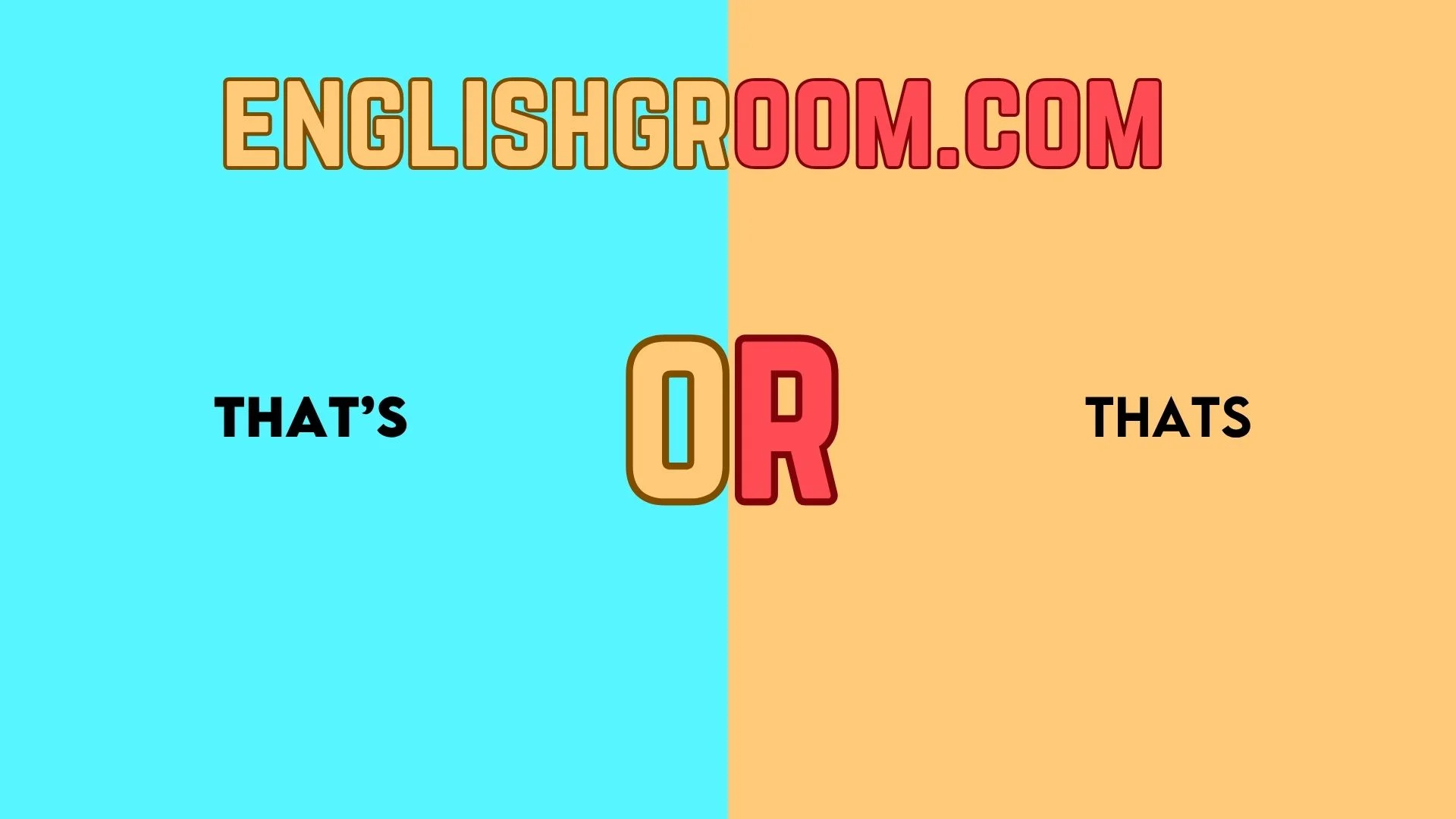
FAQs About “That’s” vs. “Thats”
What does “that’s” mean?
“That’s” is a contraction for “that is” or “that has.” It combines two words to make writing and speech smoother.
Is “thats” ever correct?
Only when referring to the car model Honda Thats. In every other case, it’s incorrect.
How do I know when to use “that’s” or “that has”?
Try expanding the sentence. If “that has” fits logically, that’s the correct meaning.
Why do people drop the apostrophe?
Mostly out of habit or speed. Informal writing and texting often skip punctuation, but it’s best to include it for clarity.
Can “that’s” show possession?
No. “That’s” is never possessive. Use “whose,” “its,” or “the [noun]’s” for possession instead.
Conclusion
In English, apostrophes might look tiny, but they change everything.
“Thats” might sound like “that’s,” yet only one belongs in proper writing.
Keep this in mind:
If it replaces “that is” or “that has,” it’s “that’s.”
If it doesn’t — it’s wrong (unless you drive a Honda).
Good writing isn’t about perfection; it’s about care. Paying attention to details like apostrophes shows readers you value clarity, accuracy, and respect for language.
So next time you write, pause for one second — add that tiny mark — and you’ll instantly sound more polished and professional.

Hi! I’m Sami, a 28-year-old content writer with a love for words and storytelling. Writing has always been my way of expressing ideas, sharing knowledge, and connecting with people. I enjoy creating engaging and well-researched content—whether it’s blogs, articles, or social media posts—that not only informs but also inspires readers. My goal is to turn complex ideas into clear, creative, and meaningful pieces of writing that leave a lasting impact.
